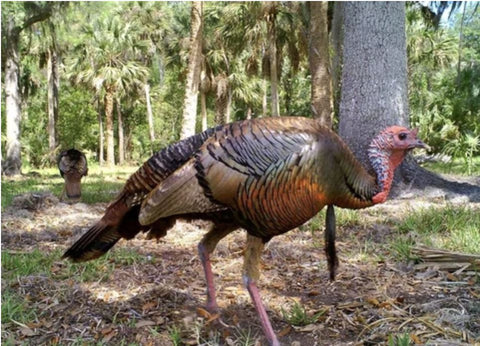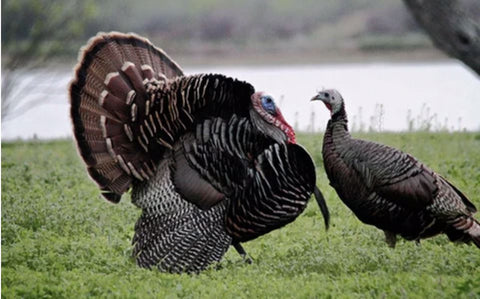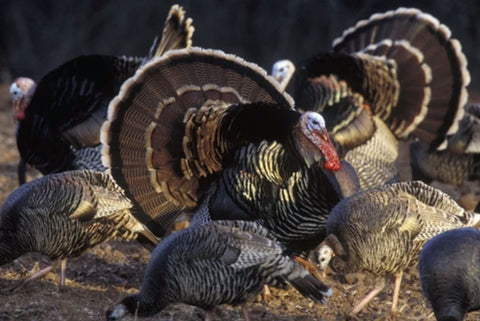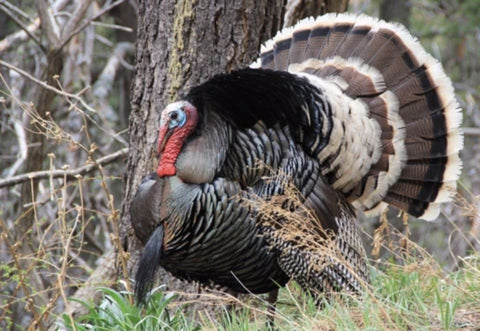
Turkey Grand Slam: Every Hunters Dream
The Turkey Grand Slam Is Challenging Yet Its The Greatest Turkey Hunting Achievement.
The turkey grand slam is every hunters dream of completing. This single-season record is accomplished by harvesting at least one of the four subspecies of Wild Turkey in the USA. The sub-species of turkeys include the Osceola, Eastern, Rio Grande, and Merriam Turkeys. Our guide for accomplishing the grand slam turkey's feat will help you get it more manageable. We will walk you through learning about them, their habits, and where you can find them on a budget! First, we will begin with the most difficult mature gobbler to flop, the Osceola Subspecies.
What is the turkey grand slam?
Sure, you are wondering what exactly are the different variations of the turkey grand slam. To find this, you must look at what the NWTF recognizes. In the USA, you will find three different turkey slams. If you are an avid turkey hunter, chances are you already know them, or you are currently trying to accomplish them.
1) Wild Turkey Grand Slam
This feat features the four most common wild turkey species in North America. These include Eastern, Merriam's, Osceola, and Rio Grande wild turkeys. Accomplishing this slam will have you traveling around the country during turkey hunting season.
2) Wild Turkey Royal Grand Slam
The royal grand slam includes all 4 of the common wild turkey subspecies and a Gould's turkey. The Gould's wild turkey is the fifth known wild turkey subspecies found in the southern portions of Arizona and New Mexico, and northern Mexico.
3) Wild Turkey World Grand Slam
If you are the ultimate turkey hunter, then the world slam may be what you are seeking. This slam features all the turkey species in the royal slam but adds a Mexico ocellated turkey to the mix.
Accomplishing any one of these turkey slams is quite the feat. Let's not forget about the Canadian turkey slam and the Mexican turkey slam. Each consists of shooting an Eastern and a Merriam's in any Canadian province, or a Rio Grande, Gould's, and Ocellated south of the border.
What turkeys are in grand slam turkey hunt?
1. Osceola turkey : Swamp Gobbler Of South Florida

Osceola Wild Turkey in Florida
Osceola Turkey Range
The Swamp Gobbler or Osceola Turkey can only be found in South Florida. All turkeys below Ocala, St Augustine, and Cedar Key can be considered pure Osceola Turkeys.
Florida Osceola Turkey Appearance:
One of the prettiest and most colorful wild turkeys in Florida is the Osceola. They have unique markings that set them apart from the other subspecies. They have very faint and broken white bands on their wing feathers, making their darker wings one of the most common identifiers of them. Osceola turkeys are also smaller than their Eastern counterparts. They live in swamps and flood-prone areas and also have large spurs.
Osceola Turkey Hunting
These birds are limited to a small area, which makes it difficult for people to get the ability to hunt them. Most land is private and is either leased or not huntable. However, you can find some top-notch guide services in south Florida to take you on your dream Osceola hunt. An Osceola turkey hunt will cost anywhere from 800-2500, and guides have a very high success rate.
If you want a cheaper option for getting a chance at an Osceola Turkey, there are some great public land opportunities in South Florida. Apply to one of the many quota hunts put on by the state on public land. Quota hunts open in early November and are the best hunting opportunities based upon the limitations. Apply online or through the mail with the state of Florida. Any WMA south of that line will have turkeys. Along the St. Johns River and the Tampa area are significant areas to target. After a failed attempt to be drawn for a turkey hunt, the WMA will award a reference point for the following year to increase your chances. Several WMAs also do not need a quota to hunt, but they are usually crowded. Big Cypress WMA, Lochaloosa WMA are open entirely, and some free up after the designated quota hunt. But the later in the season it gets, the less mature birds are still available. There are 167 WMAs in Florida, but the northern part of the state has Eastern's and Hybrids. Florida public land has plenty of opportunities if you are willing to put in the work to be successful.
Osceola Turkey Behavior
The Osceola Habits are similar to any other turkey, but they are a lot less vocal. Especially on public land. They get "hened up" and get "fired up" depending on the time of year, weather, and breeding stage. Toms will sit on islands in the middle of swamps when its warm and won't leave, making it difficult to hunt them. Osceola hunting is earlier than other states due to the short, sometimes nonexistent, winter in Florida. However, remember a turkey is a turkey, and they will be in fields and oak hammocks, as well as swamps, depending on pressure and weather.
2. Eastern Wild Turkey

Eastern Wild Turkey In Georgia
Eastern Wild Turkey Range
The Eastern is by far the most abundant turkey subspecies in the United States. They are ranging over the entire eastern United States from North Dakota to Texas, Maine to North Florida, and everything in between. There are plenty of opportunities in all of these states. Some of my favorite state to hunt them in is Tennessee, Alabama, Georgia, and South Carolina. The state of Tennessee has an incredible turkey population and many hunting opportunities. Turkeys reintroduced to the state of Tennessee, and the community has exploded over the last few years. The turkey limit is set at four birds, and the Wildlife Management Areas encompass many of the states. Some area in this state has quota hunts which are great to beat the crowds and almost guarantee an opportunity at a bird. Some places to concentrate on are South Cherokee, North Cherokee, North Cumberland, and Big South Fork WMAs. All have large concentrations of wild turkeys. The state of South Carolina also has a large Eastern Wild Turkey Population. The Francis Marion National Forrest is loaded with birds. You can get on one if not more birds a morning while hunting there. Hunting gobblers in the low country is an experience that everyone needs. The Mountain Hunt Unit and the Central Piedmont Hunt Unit are loaded up with birds as well. Plenty of public opportunities in this state. However, any state that has eastern wild turkeys has public land opportunities. Just do your research, scout, and I'm sure you can get it done in your state.
Eastern Wild Turkey Facts
The Eastern lives in mountains, fields, pine forests, oak draws, swamps, and anywhere with trees in the eastern United States. This bird is a hard, gobbling, timid bird that's proven to be weary during calls. They can come in silent or come in red hot. Every bird acts differently every day, so the experience will come in handy when hunting Eastern's. They are the largest of the birds weighing up to 22 pounds, and have the loudest gobble that seems to carry on for miles. Be patient when working these thunder chickens, especially on public land. Late season call softly and quietly, and you will get your chance.
3. Rio Grande Wild Turkey

Rio Grande Turkey In Texas
Rio Grande Turkey Range
The second most common subspecies of wild turkey in the United States is the Rio Grande Turkey. This bird ranges massively from Kansas to Texas, then has a small range of rivers throughout the southwest. When targeting these turkeys, the best states are Kansas, Oklahoma, and Texas. These states have open over the counter tags that can be purchased by out of state hunters. When targeting Rios, hunt the mid or western portion of the state to get away from the Rio/Eastern hybrid Gobblers that blend in these areas.
Rio Grande Wild Turkey Habitat
Rios, like other turkeys, need trees to roost in. Most of the trees in their habitat are short scrub oaks and are concentrated around creeks and natural land. Rios are very active birds, are very vocal. Locate with turkey calls, crow calls, hawk, eagle, or even coyote sounds. There are many public land opportunities to bag a Rio in all three of these states, but you need to concentrate your search near water. The Oklahoma Department of Wildlife has set up wildlife management areas, which are a great place to target these birds. Many of the large reservoirs and rivers have plenty of trees, plenty of lands, and plenty of turkeys. However, be aware of late-season pressured birds and slow down and limit calling.
Rio Grande Turkey Hunts
The state of Kansas has many WIHA or Walk-In Hunting Areas that are open to the public. The great thing about these patches of land is they are scattered, and there are many of them. The birds will move on and off these properties throughout the season, giving hunters ample opportunities to bag a Rio. And then there is Texas, a fantastic place to bag an authentic Rio. Low scrub oaks and lots of birds. A general rule for Rios and all turkeys is to find trees, and you'll find birds. True Rios can be found all over western and central Texas. Public land opportunities are abundant in Texas, but you will have to fight the crowds. Rios are marked with cream-colored tips on their tail feathers, which can be noticed at a distance but not confused with Merriam's white feathers.
4. Merriam's Wild Turkey

Merriam Turkey in Wyoming
Merriam's Turkey Range
The Merriam subspecies of Wild Turkey have fan tail feathers with almost white tips, which gives the bird a very bright look to help it blend in with snow and rocks. The Merriam turkey is only found historically within the Rocky Mountain Range. However, they have been introduced into Oregon. They inhabit high rainfall and high snowfall areas and live in Ponderosa Pine regions. They range from New Mexico to the Dakotas in high elevation areas. The population is good, and there are plenty of opportunities to find these birds on public land, but the most challenging part is getting to them.
Merriam Turkey Hunts
The Northwest corner of Nebraska is usually the closest drive for people, and it shows. Lots of public land hunters head to this area making for crowded WMAs. However, there are plenty of guides to take you to this region, but you have to book your hunt early. The wide range of these birds allows for less crowded areas all over the Central Western US. Colorado has many over the counter tag areas to hunt, primarily in the western range. Any place with Ponderosa Pines will have birds somewhere. In the winter, Merriams move down out of the high elevations to the valleys, then back up to high altitudes for the spring and summer. The most beautiful states to hunt Merriams are Montana and Wyoming, but some states are more challenging to draw tags. The mountains in these states create breathtaking views and excellent habitat for these birds. Some significant aspects about the Merriam are they will gobble at pretty much any sound, any time of day.
Also, in the early season, they will be in massive groups of birds. I have seen groups up to 400 strong. Pick a state, do your research, and you won't have any issues finding a mature Merriam long beard. The Black Hills of South Dakota is an excellent region for an out of state hunter to harvest a bird. Apply for tags well in advance of your trip. With over 1.3 million acres of land, you are sure to come into contact with a turkey. Look for creek drainages and transition areas. Be sure to roost birds the night before as they gobble hard on the roost.
Wild turkey grand slam goals
The goal to get a Grand Slam on wild turkeys is easier than ever today. Guided trips are more than available in every state. Public land and private unguided hunts are getting more complicated, with more people hunting and less land open. However, it still can be done. There are still massive amounts of public land available for hunting all across the united states. Most people do not want to put in the time or energy to be successful on public land. It requires much research about the land and tags and even more walking. Remember, a turkey is a turkey no matter where he lives. Snoods are weary and have excellent eyesight. All turkeys need to survive are trees, water, and a food source, so when finding these three things, you should find plenty of birds. Rios, Osceola, Merriam, and Eastern Wild Turkeys are all wild turkey family members and have similar habits. Refine your tactics and head out to bag your grand slam.
If you have any questions or concerns, please leave a comment below or email us at [email protected]. We would love to hear about your turkey grand slam experiences. Please send us any pictures you get this turkey season to be featured on our social media pages. For other fantastic turkey hunting tips check out the kee kee page for great gear and influential turkey hunting blogs. We hope you will read this article to help jump-start your quest for the turkey grand slam of wild turkeys.



Leave a comment